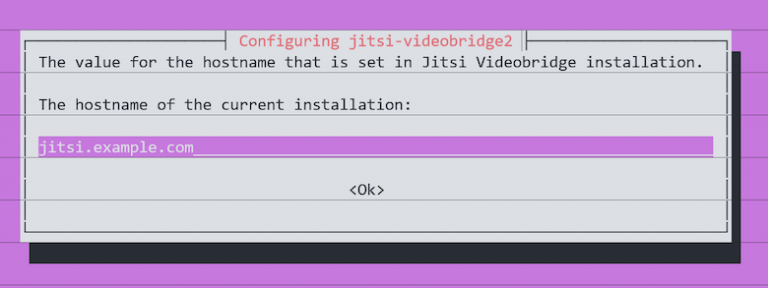

In our case we’re using as our fully qualified domain name (FQDN) and pointing it to the IP address of our VPS 134.122.106.161. In the DNS dashboard of your domain name registrar setup a DNS A record for your Jitsi server which points to the IP address of your VPS.

Setup your firewallĪ single box instance of Jitsi Meet will need the following inbound ports open: Make a note of the IP address of your VPS, in our case it’s 134.122.106.161. We wouldn’t ordinarily recommend such a small VPS but for small companies it should be fine: This one was able to handle our 6 person video call with 50-75% CPU usage, 50% RAM usage and 20-30Mbps bandwidth. Jitsi isn’t particularly storage hungry so unless you’re setting up recording you can get away with a small sized disk. Here we’re choosing the cheapest Digital Ocean VPS with 1GB RAM, 1CPU and only 25GB of storage. Size your serverįirst setup your VPS instance. Getting it setup on your own VPS literally takes less than 15 minutes (we timed it!). For the conference, it is now able to share the URL, set a password, adjust the audio and video quality, and more.Jitsi Meet Video Conference courtesy of Wikipedia To enter the conference room, type a name for your meeting and click Start Meeting. Just execute the following commands in your shell: $ sudo /usr/share/jitsi-meet/scripts/install-letsencrypt-cert.sh Conclusion Using Let’s Encrypt is the simplest method.

By doing this, you can prevent issues with a self-signed certificate. Obtaining a certificate that has been authorized by a Certificate Authority is the best approach. You require a TLS certificate to have encrypted communications. You’ll see the following screen: Step 4: Generate a Let’s Encrypt certificate (optional, recommended) Open a Web-browser and enter domain of your instance, for example. Your private Jitsi Meet instance is ready for a first conference call.
#JITSI MEET INSTALL UPDATE#
Update package versions across all repositories: $ sudo apt update $ echo 'deb stable/' | sudo tee /etc/apt//jitsi-stable.list > /dev/null To ensure this is enabled, run this command: $ sudo apt-add-repository universe $ curl | sudo sh -c 'gpg -dearmor > /usr/share/keyrings/jitsi-keyring.gpg' On Ubuntu systems, Jitsi requires dependencies from Ubuntu’s universe package repository.
#JITSI MEET INSTALL INSTALL#
$ systemctl enable rvice Step 3: Installing Jitsi meetĮnsure support for apt repositories served via HTTPS $ sudo apt install apt-transport-https Run the scripts below to install and activate Nginx: $ sudo apt install -y nginx If Nginx is installed on the system, the Jitsi installation program will handle its settings. The reverse proxy for the Jitsi web interface will be the Nginx server.
#JITSI MEET INSTALL UPGRADE#
Update the system’s existing software: $ sudo apt update & sudo apt upgrade -y Step 2: Installing nginxīefore installing Jitsi Meet, install a Nginx server. The software provides high video and audio quality and supports fully encrypted connections using TLS/SSL and Let’s Encrypt certificates. Jitsi Meet is an open-source video conferencing solution, providing virtual meeting rooms for remote team meetings.


 0 kommentar(er)
0 kommentar(er)
